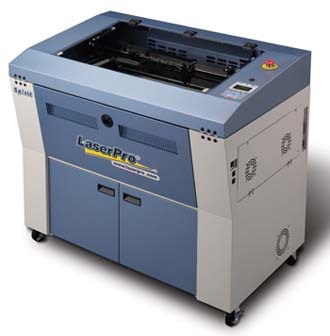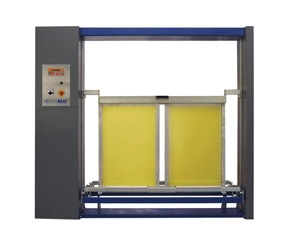Laser Engraving Opportunities for Screen Printers
Published
17 years agoon

Laser engraving systems can be a valuable and profitable addition to any screen-printing shop, giving screen printers the opportunity to decorate materials and substrates that they might not have previously considered or that their existing equipment could not support. Laser cutting and engraving systems can be used on a variety of materials. However, identifying potential applications can be a challenge. This article will discuss how these devices work and the benefits that they can bring to screen-printing operations.
The technology
Laser engraving systems can be a valuable and profitable addition to any screen-printing shop, giving screen printers the opportunity to decorate materials and substrates that they might not have previously considered or that their existing equipment could not support. Laser cutting and engraving systems can be used on a variety of materials. However, identifying potential applications can be a challenge. This article will discuss how these devices work and the benefits that they can bring to screen-printing operations.
The technology
Most engravers use CO2-charged lasers to produce precise and detailed images at a very high speed. They are commonly referred to as XY laser systems or cabinet lasers, in reference to the X rail and Y rail assemblies along which the laser moves and the fact that the system is enclosed (Figure 1). The overall throughput of the machine greatly depends on the power output (wattage), the speed, which is measured in in./sec (IPS), and, most importantly, the acceleration of the engraving motion of the machine.
Some lasers on the market specialize in one function over another. For example, one system is specially designed to vector cut materials up to 1.5 in. thick and has a large table size, which makes it suitable for someone who mainly does a lot of cutting. For most businesses, it’s important to have a machine that can handle as many different jobs as possible. Therefore, using a laser that can raster engrave on marble and then vector cut acrylic is vital to those who must maximize their resources.
The CO2 laser is the most common system in the engraving market because it can cut and engrave on acrylics, wood, marble, leather, fabrics, plastics, and even anodized or coated metals. Within the CO2 segment, there are metal and glass CO2 tubes; each with its own advantages.
AdvertisementGlass tubes tend to work great for vector cutting and, at the same time, produce smooth, clean raster images. Glass tubes, which include a glass housing filled with the CO2 element, tend to exhibit less pulsing than metal tubes. Because the power fluctuation is minimized, vector cuts come out cleaner, and raster images show less traces of banding. As great as this sounds, the major drawback of glass tubes is the fact that the lifespan is much shorter than metal tubes. So the cost of owning a machine with a glass tube goes way up as you must frequently replace the laser tube. A related concern is the machine downtime that occurs when a tube must be replaced.
Metal tubes, on the other hand, do tend to exhibit power fluctuations and pulsing. Still, adjusting raster and resolution settings can yield very professional, clean raster images and vector cuts. The major attraction of a metal laser tube is its lifespan. The average life is 20,000-35,000 hours of use. That amounts to eight hours a day at 100% power, seven days a week, for seven years, if the tube only lasts for 20,000 hours. But the tube will often last longer than that.
Also available are Nd+:YAG and Nd+:YV04 lasers. These lasers are geared to those who wish to mark on raw (uncoated) metals; as such, they’re usually found in manufacturing and high-end technology companies. These lasers operate differently from the standard XY laser systems in that they utilize a galvo lens to direct the laser beam. Because of this setup, the laser can engrave much faster than an XY system; however, the working area is usually much smaller.
To use any of these systems, the operator first creates or imports an image to a standard graphic design program. Once the image is prepared, the operator uses the program’s Print command to open the driver for the engraver, which opens additional option fields for engraving the image.
The capabilities and options of the laser engraver greatly depend on the driver. At this stage, the user can select the raster style and resolution, set the home position, and adjust power and speed settings. Some drivers even allow users to adjust the pitch and sharpness of engraved edges for applications such as rubber stamps. The user then inserts the substrate into the machine, typically into the top left corner of the table, which is commonly used as the home position and is the starting point of the laser. After focusing the laser on the material (most machines offer an auto-focus function), the user pushes the start button and the laser fires away.
Multiple capabilities
AdvertisementMost systems are capable of performing cutting and engraving functions. When choosing a laser, it’s important to consider which of the two functions you will need most frequently, because some systems may perform one function better than the other. Wattage plays a big role in how well the machine will work. When it comes to photo engraving, a 30- or 40-watt laser usually will suffice. However, when it comes to cutting, particularly with thick materials, you may consider a laser ranging from 60-100 watts, or even 200 watts. You’ll need more power to cut completely through material, whereas in engraving you are cutting to a depth of only a few millimeters.
The use of a higher wattage machine certainly opens more doors. Not only will you be able to cut or engrave more materials, but you will also do so much more quickly and cleanly than you would with lower wattage machines. Therefore, when purchasing a new laser engraver, consider purchasing one that has a higher wattage than what you think you might need. This will give you room to expand and take on jobs that you may not have been able to complete with a lower powered laser. Purchasing a machine with room to grow is simpler and typically less expensive than trying to upgrade your machine to a higher wattage down the line.
Opportunities for screen printers
Laser engraving systems allow users to etch very fine and detailed graphics (including 4-pt type) onto wood, rubber, or any carbon-based materials to create stencils, which can then be used in screen-printing applications. The laser engraver also can be used to cut printed images.
Another creative use of the laser engraver involves 3D engraving and then running the engraved piece though a flatbed printer. This will give the engraved piece color, depth, and a unique look.
CO2 lasers can mark on a variety of materials, such as acrylics, leathers, fabrics, denim, marble, rubber, and most plastics (Figure 2). However, the laser cannot mark or cut metallic materials. This is because the laser beam will reflect directly off of metal surfaces, with no effect to the material at all. But if the metal is painted, coated, or anodized, the laser will remove the top layer to expose the metal underneath. The result is a sharp, crisp marking that is ideal for plaques and trophies.
Laser engravers are typically equipped with a Windows-based driver. Users can choose their own graphics-editing programs. Most laser engravers function simply as a printer, so no special software is required. Graphics programs that are commonly used to edit images for laser engraving include CorelDRAW, AutoCAD, Adobe Illustrator, and Adobe Photoshop. You should use the software that you prefer, but it should be able to work effectively with the file types you commonly use. Some programs may work great with bitmap images but cannot process vector images. Other applications written specifically for laser engraving may also be used.
AdvertisementSome systems offer the capability to contour cut printed graphics based on the original digital design file. These systems use an integrated camera to recognize the contour lines of an image and cut them out. Some laser engravers offer an optional CCD camera module that allows users to do precise contour cutting. Using a laser for cutting really opens up a whole new world of possibilities. Not only will you be able to contour cut, but you also will be able to vector cut around the details of an image or even engrave into the material as well. By using a laser, you are not restricted to outside perimeter contour cutting alone.
Several laser engravers feature exclusive functions, such as 3D engraving, which allows the user to engrave deep into wood or acrylic, resulting in a multidimensional effect (Figure 3). Other functions include stamp mode for creating rubber stamps and rotary attachments to engrave on cylindrical objects such as mugs or vases. Also, systems designed with front and rear pass-through doors offer virtually unlimited height, enabling users to take on jobs that they might have otherwise turned away. This feature is ideal for those who wish to engrave on long objects, such as baseball bats, gun stocks, and wood paneling.
Important considerations
Screen printers should keep a few things in mind when investigating laser cutting or engraving systems for their shops. First, test the system’s engraving or cutting quality. With so many laser engraving systems on the market, it can be difficult to choose the one that best fits your needs. Also, many people wish to shop around for the lowest price. Although buying a low-cost laser may be good for your wallet, it may not be the best decision in the long run. Keep in mind that not all machines are created equal, and as the old adage goes, "You get what you pay for."
The main things to consider when assessing a laser engraver include the motors, rail system, driver, and laser tube, as well as the technical service and warranty offered by the manufacturer. The motors on a laser engraving system are vital in making precise cuts. If a motor loses its place, it can ruin an engraving job, especially if a job requires multiple passes over the same area. DC servo motors are best and provide consistent and accurate cuts.
The rail system must provide smooth and frictionless movement. Some systems employ a low-maintenance motion linear bearing system to ensure effortless and smooth operation. The driver is another critical component that determines the flexibility and functionality of the equipment. The driver should be easy to navigate and operate. The more features it offers, the more options and control you have over your work. Finally, remember that the laser tube is the heart and soul of any laser engraver. Make sure that the tube is from a reputable source. Stay far way from off-brand tubes.
One of the most overlooked aspects of owning a laser engraver is technical support. Laser engravers are very complicated pieces of equipment. If a part were to fail, who would you turn to for assistance? Make sure your dealer will be able to assist you in case you are ever in need of service. Also check to see what kind of warranty the manufacturer offers. Some warranties are longer than others. Find out the length of the warranty and determine precisely what it covers. Wear-and-tear items usually are not included in the warranty, so be sure to check the price of replacement parts.
Considerations should focus on more than just price, features, and warranty. Also ask yourself the following questions: Is the output precise enough to be used for producing stencils? Do we need better output quality? Is the output quality consistent? Are there any hidden costs for training and maintenance? Will there be any chemical reactions with the materials that we plan to process? Harmful chemical byproducts may damage the machine and harm the operator. These byproducts can be created when working with materials such as PVC or Teflon.
In the end, just be sure to research and do your homework. A laser engraving system is one of the best investments you can make for your business. As long as you know what your needs are and understand what the system can and cannot do, you’ll be on your way to a future of profitable laser cutting and engraving.
About the authors
Jerry Loya is the North American laser sales representative for GCC America, a manufacturer of laser-engraving systems with offices in Walnut, CA.
William Chai started as a laser technician for GCC at the company’s Taiwan headquarters in 2002. He now handles marketing for GCC’s laser division in Taiwan.
SPONSORED VIDEO
Let’s Talk About It
Creating a More Diverse and Inclusive Screen Printing Industry
LET’S TALK About It: Part 3 discusses how four screen printers have employed people with disabilities, why you should consider doing the same, the resources that are available, and more. Watch the live webinar, held August 16, moderated by Adrienne Palmer, editor-in-chief, Screen Printing magazine, with panelists Ali Banholzer, Amber Massey, Ryan Moor, and Jed Seifert. The multi-part series is hosted exclusively by ROQ.US and U.N.I.T.E Together. Let’s Talk About It: Part 1 focused on Black, female screen printers and can be watched here; Part 2 focused on the LGBTQ+ community and can be watched here.
Advertisement

Inkcups Announces New CEO and Leadership Restructure

Hope Harbor to Receive Donation from BlueCotton’s 2024 Mary Ruth King Award Recipient

Livin’ the High Life
Advertisement
Subscribe

Bulletins
Get the most important news and business ideas from Screen Printing magazine's news bulletin.
Advertisement
Most Popular
-

 Art, Ad, or Alchemy2 months ago
Art, Ad, or Alchemy2 months agoF&I Printing Is Everywhere!
-

 Case Studies1 month ago
Case Studies1 month agoHigh-Density Inks Help Specialty Printing Take Center Stage
-

 Andy MacDougall2 months ago
Andy MacDougall2 months agoFunctional and Industrial Printing is EVERYWHERE!
-

 Columns2 weeks ago
Columns2 weeks ago8 Marketing Mistakes Not to Make When Promoting Your Screen Printing Services Online
-

 Editor's Note2 weeks ago
Editor's Note2 weeks agoLivin’ the High Life
-

 Marshall Atkinson2 weeks ago
Marshall Atkinson2 weeks agoHow to Create a Winning Culture in Your Screen-Printing Business
-

 Thomas Trimingham2 months ago
Thomas Trimingham2 months ago“Magic” Marketing for Screen Printing Shops
-

 News & Trends1 month ago
News & Trends1 month agoWhat Are ZALPHAS and How Can You Serve Them in Your Print Business?











